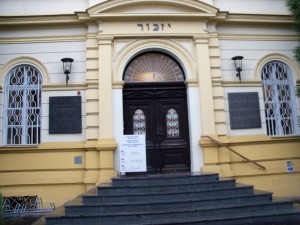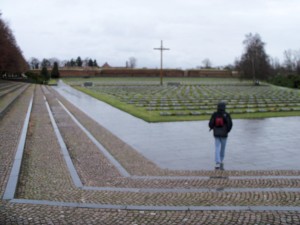Figuring out how to get to Terezin was the first challenge. It involved navigating the Prague metro and a largely deserted bus depot on a chilly gray January morning. The next order of business was to find out the correct bus, and I made my way to the battered trailer that served as the ticket office. After buying the tickets, I went to search for the bus. There weren’t very many passengers, and the bus was about half full. That came as a surprise to me. I had expected that there would be many people visiting Terezin, but that wasn’t the case.
On the hour-long bus ride, we drove out of the busy city and passed through lush farmland and sparsely populated areas. It wasn’t long before the bus arrived at the town of Terezin, and dropped us off in the center of town in front of a large tan and cream-colored building.
Steps led up to a dark brown door, and above the door was the Hebrew word yizchor (remember). Square memorial plaques were fixed on either side of the door, one with a Star of David engraved on it. A white sign out front read Terezin Memorial Ghetto Museum in several languages.
I climbed the steps and went inside. There were very few people inside, and I was accompanied by quiet and emptiness as I paid my admission and went into a large, expansive room which exhibited photographs and poetry of the children who were imprisoned there.
The wooden floorboards creaked as I entered, and I stopped short when I saw the name beneath the photograph of a dark-haired young boy. Franta Bass. I remembered his name from several poems, remembered that he had been murdered as a young teen at Auschwitz, but had no idea that any photograph of him remained. I stared at the serious face for the first time, and I felt emotion well up inside me, tightening my throat as I recalled his poem, “I Am a Jew”.
When I first read that poem, I was deeply moved. No matter how horribly Jews were treated, Franta was determined to always be proud of his people. He swore that he would always be faithful to the Jewish people no matter what happened, that despite the brutality he endured, he would live on.
I stared at the image of the young boy who wrote those powerful words, the boy who was murdered by the Nazis, and I silently mourned the unspeakable loss of him and of millions of other children. After a time, I exited the room, knowing he would live on in my memory.

